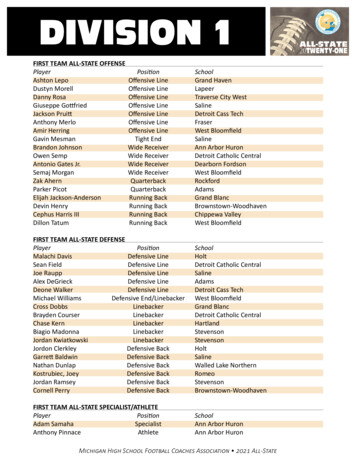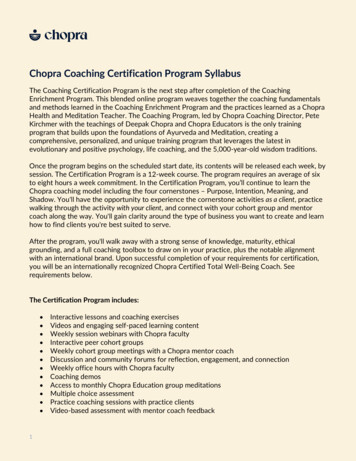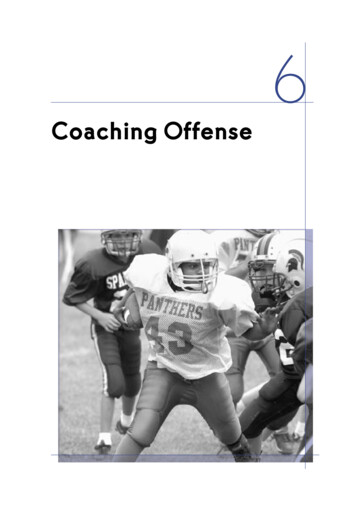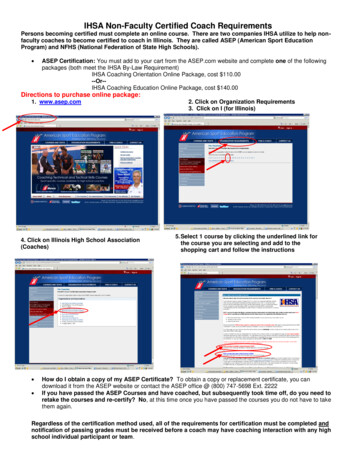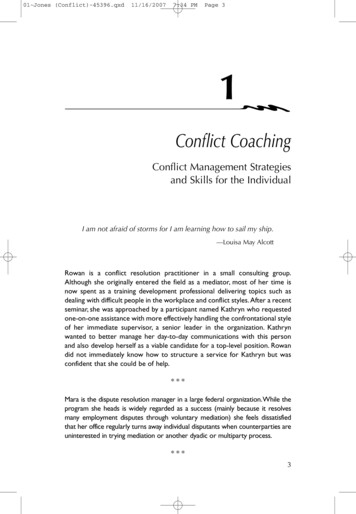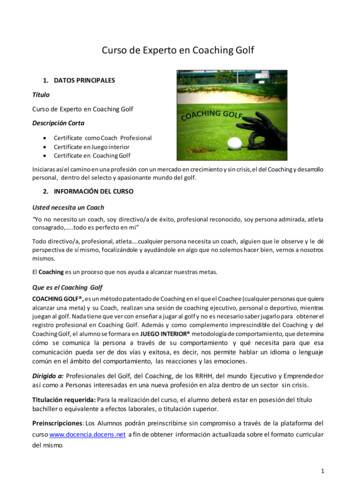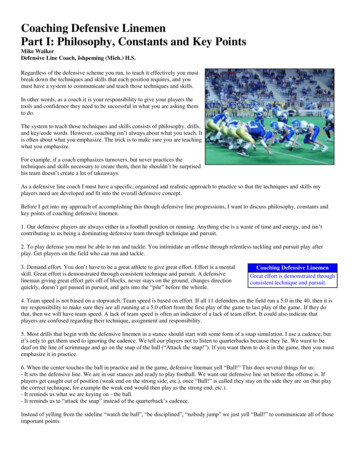
Transcription
Coaching Defensive LinemenPart I: Philosophy, Constants and Key PointsMike WalkerDefensive Line Coach, Ishpeming (Mich.) H.S.Regardless of the defensive scheme you run, to teach it effectively you mustbreak down the techniques and skills that each position requires, and youmust have a system to communicate and teach those techniques and skills.In other words, as a coach it is your responsibility to give your players thetools and confidence they need to be successful in what you are asking themto do.The system to teach those techniques and skills consists of philosophy, drills,and key/code words. However, coaching isn’t always about what you teach. Itis often about what you emphasize. The trick is to make sure you are teachingwhat you emphasize.For example, if a coach emphasizes turnovers, but never practices thetechniques and skills necessary to create them, then he shouldn’t be surprisedhis team doesn’t create a lot of takeaways.As a defensive line coach I must have a specific, organized and realistic approach to practice so that the techniques and skills myplayers need are developed and fit into the overall defensive concept.Before I get into my approach of accomplishing this though defensive line progressions, I want to discuss philosophy, constants andkey points of coaching defensive linemen.1. Our defensive players are always either in a football position or running. Anything else is a waste of time and energy, and isn’tcontributing to us being a dominating defensive team through technique and pursuit.2. To play defense you must be able to run and tackle. You intimidate an offense through relentless tackling and pursuit play afterplay. Get players on the field who can run and tackle.3. Demand effort. You don’t have to be a great athlete to give great effort. Effort is a mentalskill. Great effort is demonstrated through consistent technique and pursuit. A defensivelineman giving great effort gets off of blocks, never stays on the ground, changes directionquickly, doesn’t get passed in pursuit, and gets into the “pile” before the whistle.Coaching Defensive LinemenGreat effort is demonstrated throughconsistent technique and pursuit.4. Team speed is not based on a stopwatch. Team speed is based on effort. If all 11 defenders on the field run a 5.0 in the 40, then it ismy responsibility to make sure they are all running at a 5.0 effort from the first play of the game to last play of the game. If they dothat, then we will have team speed. A lack of team speed is often an indicator of a lack of team effort. It could also indicate thatplayers are confused regarding their technique, assignment and responsibility.5. Most drills that begin with the defensive linemen in a stance should start with some form of a snap simulation. I use a cadence, butit’s only to get them used to ignoring the cadence. We tell our players not to listen to quarterbacks because they lie. We want to bedeaf on the line of scrimmage and go on the snap of the ball (“Attack the snap!”). If you want them to do it in the game, then you mustemphasize it in practice.6. When the center touches the ball in practice and in the game, defensive lineman yell “Ball!” This does several things for us:- It sets the defensive line. We are in our stances and ready to play football. We want our defensive line set before the offense is. Ifplayers get caught out of position (weak end on the strong side, etc.), once “Ball!” is called they stay on the side they are on (but playthe correct technique, for example the weak end would then play as the strong end, etc.).- It reminds us what we are keying on - the ball.- It reminds us to “attack the snap” instead of the quarterback’s cadence.Instead of yelling from the sideline “watch the ball”, “be disciplined”, “nobody jump” we just yell “Ball!” to communicate all of thoseimportant points.
7. We want to be the world’s fastest 2-yard sprinters. A 2-yard sprint puts our heels on the heels ofthe offensive lineman and reestablishes the LOS on their side of the ball. We don’t want ourdefensive lineman any deeper than a yard across the LOS unless they are attacking the ball. Ballcarriers have to come to the LOS, so we want to control the LOS without creating seems and cutbacklanes.Coaching Defensive LinemenWe want to be the world’sfastest 2-yard sprinters.It is during the 2-yard sprint that we read offensive linemen and blocking schemes. If it takes defensive linemen longer than that toread blocks they can’t consistently stop trap, defend the reach block, or defeat a double team.8. The only thing that a blocker is allowed to touch on defensive linemen isthe top of their arms and the top of their shoulder pads (get your chest on yourknee and keep you butt away from the blocker). This reinforces keeping ourpad level low.At the start of every defensive practice I ask the players to show me what theoffense is allowed to touch. They immediately get into a good footballposition with their shoulders behind their shoulder pads and run their handsover the top of their arms and shoulder pads.From this position a blocker shouldn’t be able to get to their numbers, hips, orlegs. This stance also puts us into a good power angle and allows us to usefull body strength to take onblockers and ball carriers.Coaching Defensive Linemen9. The single most important factor The single most important factor inin controlling the LOS is a low pad controlling the LOS is a low pad level.level. I call it playing “chest onknee”. We literally want to practiceat that level, with our shoulders that low and our back that flat while attacking the LOS and defeating blocks. If I can see the numberon the front of your jersey your pad level is too high.All through practice you will hear me remind players to play with “chest on knee” and to make their “numbers disappear”. Theintensity, speed and excitement of a game will cause a natural rise in pad level, but by emphasizing this low level during practice westill play at a good level during the game.10. We want to keep our power angle on all contact. We don’t rise up on contact to defeat a block - we don’t snap or roll our hips oncontact. Instead, we control the LOS and defeat blockers by keeping our pad level low and not giving up our power angle whilemoving forward - not up.The most important muscle groups for defensive linemen are their gluts and thighs. When we talk about a power angle we are talkingabout keeping our body in a position so we can take advantage of our gluts and thighs on all contact. The power angle consists of a“Z” in the knees, ankles behind the gluts, feet and knees pointing to where we want to go (not pointing out), hips locked to keep a flatback, shoulders behind shoulder pads, shoulders squared to contact, and eyes/head up so we can see where we are going and what weare hitting.
Again, during the game there is a natural rise, but if we emphasize the power angle throughout practice we will play much lower whenwe attack blockers on Friday nights.11. All initial contact is made with our shoulders - not with our hands - in the center of the offensive lineman’s chest, which keeps usin a good power angle with a low pad level. We want the full force of our body to neutralize the initial approach of the offensivelineman and to run through the contact - to continue to move forward instead of trying to hold our ground.We want contact in the center of the offensive lineman’s chest. We don’t want to chip or hit the edge of the shoulder pads, but insteadwant a full force “slam” into the chest of our opponent. Once we’ve made solid contact we shoot our hands inside and work to extendour arms to separate from the blocker. As we shed the blocker we still want to play as low as we can without giving up our powerangle.12. Hand placement should always be inside the “Pentagon”, the area from the neck, to theshoulders, to the pecs, with the thumbs pointing up and elbows inside the frame of your chest.This will maximize your players upper body strength when taking on blockers.Coaching Defensive LinemenHand placement should always beinside the “Pentagon”, the area fromthe neck, to the shoulders, to the pecs.An easy way to demonstrate this is to have a player fully extend his arms in front of him with his fingers pointing up. Grab him by thewrists and push his arms down while the player resists. He will struggle to keep his arms up. Then have him point his thumbs up. Thistime it will be easier to resist the pressure. By simply turning the thumbs up it allows him to use his upper body muscles and jointsfrom a more powerful angle.A great hand placement technique is to have players click their wrists together as they are working their hands into the Pentagon. The“wrist click” forces their thumbs up and reinforces keeping their hands inside the Pentagon.13. All defensive linemen have two basic block reactions - dip or squeeze. Any time a player isblocked he automatically dips - resets his power angle and pad level by putting his chest on hisCoaching Defensive Linemenknees. It doesn’t matter if the block comes from the player in front of him, from the inside,All defensive linemen have two basicoutside or the backfield, if he gets blocked, he dips to defeat the blocker and control his gap.block reactions - dip or squeeze.If he doesn’t get blocked, he squeezes to the inside. He doesn’t hold his ground and looks for
the next blocker, he instead literally “squeezes” all of the air out of the inside gap. He breaks off his penetration, and goes flat downthe LOS and eliminates all air between him and the next blocker. It doesn’t matter if his visual key releases to the outside, inside ordown blocks, if he isn’t blocked he squeezes the inside gap.It is important to understand that we dip on all contact, so after squeezing, the defender still dips to take on a trapper, or kick out blockby a back, etc.14. Safety has to be an important factor in everything we do on the practice and game field. Twoof the most important things we can teach our players are to keep their feet moving at all timesand to see what they hit.- Keep your feet moving: There are two keys aspects to this. First, most serious leg injurieshappen when a player is flat footed. When your feet are dug into the ground (pushing, leaning,overextending your legs) there is no give if a player contacts your legs from any angle.Coaching Defensive LinemenSafety has to be an important factorin everything we do on the practiceand game field.The second thing regards the old “hammer” and “nail” analogy. During contact the player with the most momentum is going to deliverthe blow. The slower, or stationary player, is going to receive the brunt of the blow. By teaching your players to give maximum effort(which keeps their feet moving) it can reduce the chance of injury.- See what you hit: A catastrophic injury can occur when a player makes contact with his head down. By taking the blunt of a blowon the top of the head it puts a great amount of stress on the neck and spine. Here is a simple way of demonstrating the unnecessaryrisk players put on their bodies by putting their heads down on contact. Have your players tuck their chins against their chests as tightas they can. They will feel some stress on the back of their necks. Then have them put their hands on the back of their heads and applypressure. The pressure on their neck and spine is very obvious. Ask them to imagine the amount of pressure that would be applied totheir neck and spine if they made contact in this position while at a full sprint.Then have them lift up their heads and look at you, and again apply pressure to the back of their heads. The difference is obvious andthey get the point. By teaching players to keep their eyes/head up - to see what they hit - reduces the chance of catastrophic injury.Here is a great link about how to reduce head and neck injuries in football provided by theNational Trainers’ Athletic Association.15. There are a lot drills you can use to teach skills and techniques. However, it is more importantto have drill categories than to have drills. We have identified eight drill categories that defensivelinemen need to be successful: Stance/Starts, Running/Pursuit, Tackling, Turnovers,Separation/Escape, Anti-Block, Anti-Score, and Keys/Blocking Schemes.Coaching Defensive LinemenIt is more important to havedrill categories than to have drills.Within each category we have several drills that emphasize and teach the category. Based on the goals of each practice we will choosespecific categories, then we will select the drills we want from that category. It is important to practice each category, it is notimportant to use each drill in the category. As often as possible we combine categories such as adding a turnover component totackling drills.During two-a-days we have more time in group work, so we will often hit each category in a practice, or at least over two practices.We may spend more time in some categories then others, but we will hit them all. As the season progresses, as practices get shorter,
and the amount of time we have in group work is reduced, we won’t be able to hit every category in every practice, but we will hitevery category during the week.16. Everything you teach must “stack”. There must be a logical order to what you are teaching regarding terminology and theprogression of skills and techniques. For example, if you are doing a drill that starts from the stance, then don’t allow the stance to getsloppy just because it isn’t the focal point of the drill. If you let each point disappear as you go to the next progression, then you aregiving your players inconsistent messages and aren’t emphasizing the things that will make them successful.17. Name your drills. This communicates to your players what you are about to do, the goal of the drill, and how to set up it in thequickest time with the minimum amount of description or direction.18. You should see your drills in game film. If you don’t see your drills in game film, then either the drills aren’t being taught right, orthe drills are unnecessary. While watching film with your players point out the drills (or ask them to point them out to you). This is agood way to reinforce - and create confidence in - what you are teaching.19. You increase efficiency in performance by eliminating variables. If it takes a player sixphases to do one technique, there are six opportunities to do the technique wrong. If you canget that technique down to three variables, then you increase the player’s chance ofaccomplishing the technique by 50 percent.Coaching Defensive LinemenYou increase efficiency in performanceby eliminating variables.A perfect example of this is our dip or squeeze philosophy as our two basic block reactions.20. One of the most important things you can emphasize with your players is to “finish strong”. Help them to develop the habit offinishing the rep, drill, play, practice, and game stronger than they started it. Finishing strong demonstrates effort, a team first attitude,and mental toughness.21. Film your practices. Why should game film be your only source to identify costly technique or assignment mistakes? Why notidentify and correct those mistakes before you play the game?22. You have to have players that enjoy competing, and accept the challenges that comes with competition. You can developcompetitors by making competition an important part of the off-season and during the season. Find ways to compete during drills, inthe weight room, with running drills, etc. Get them used to competing as much as possible while always emphasizing to “win the drill”(rep, 1-on-1 match up, tackle, block, game, etc.).23. The number one thing I look for in a player is performance. Can he get the job done? I once played a backup safety on thedefensive line over big strong kids that couldn’t make a play. He wasn’t going to put either of the starting safeties on the bench, but hewas a good enough athlete that we had to get him on the field. We put him on the line and he had three sacks his first game.Common traits for players that make plays include effort, a positive, coachable attitude, being a competitor, and mental toughness. Amentally tough player is one who gives his best every play against superior and inferior opponents, who doesn’t offer any excuses, andwho responds to challenges and adversity with his best effort. Sometimes we make the mistake of playing a kid with potential basedon size, strength, or reputation instead of looking at what really matters: does the kid make adifference when he’s on the field.Coaching Defensive Linemen24. Defensive linemen must understand the 3 A’s of Defense: Alignment, Assignment, Attack. ADefensive linemen mustlineman can’t always control what’s going to happen to him after the snap, but he can control most understand the 3 A’s of Defense:of these things before the snap. Alignment includes stance and lining up at the correct spot at theAlignment, Assignment, Attack.correct depth. Assignment includes knowing your technique (base, slant, etc.), visual and pressurekeys, and responsibilities (which gap does he have, does he have contain, pitchman, etc.). Attackincludes attacking the snap, attacking the blocker and attacking the ball.The is no excuse for a breakdown in the 3 A’s of Defense. These are all things we can control. Our opponents are well coached, andthey don’t need our help. If a player understands the 3 A’s of Defense, it makes him a better player and us a better defense. In everydrill we want to incorporate some form of the 3 A’s of Defense.25. Require your players to coach each other during all phases of practice because the one doingthe work is doing the learning. If I am doing all of the work on the practice field then I am doingmost of the learning. As the old saying goes, it’s not important what the coach knows, it’simportant what the players know. By encouraging and expecting players to coach each other itcauses three things to happen.Coaching Defensive LinemenRequire your players to coach eachother because the one doing thework is doing the learning.First, in order to teach something you have to understand it. So if a player is able to teach a teammate, then that means he understands
the technique, assignment, etc. This makes players responsible and accountable to each other.Second, it teaches players how to communicate and problem solve. I can’t see everything going on in drills, in team, and especiallyduring the game. However, if players are encouraged to coach each other, they can make adjustments during practice and gamesinstead of waiting for coaches to make all the corrections or adjustments.Third, it introduces leadership and positive peer pressure to the team. We have all coached the player who takes everything personaland is convinced he is doing everything right regardless of what you say. But teammates rarely treat each other that way. They areoften more receptive to each other, especially if it’s one of your “stars” who is doing the coaching. If you hit this level of leadership itwill have a major impact on your team.
Coaching Defensive LinemenPart II - Practice Categories and Drills:Stances/Starts, Running/PursuitMike WalkerDefensive Line Coach, Ishpeming (Mich.) H.S.In the first part of this series, we discussed philosophy, constantsand key points of coaching defensive lineman. In the followingparts we will discuss what we do in practice.When it comes to teaching the techniques and skills defensivelinemen need to be successful in our defensive scheme, we usethe eight drill categories we introduced in Part I, 15:Stance/Starts, Running/Pursuit, Tackling, Turnovers,Separation/Escape, Anti-Block, Anti-Score, and Keys/BlockingSchemes. I will give examples of some of the drills we use ineach category.Again, within each category we have several drills thatemphasize and teach the category. Based on the goals of each practice we will choose specific categories, thenwe will select the drills we want from that category. It is important to practice each category during the week,but it is not important to use each drill in the category. As often as possible we combine categories such asadding a turnover component to tackling drills.One key point to include in most drills is when a player’s rep is over, he SPRINTS back to his starting point,while the next athlete is already set for his rep. This allows you to evaluate the focus and discipline of yourplayers while reinforcing the attitudes and expectations that you are demanding from them.The following covers the Stance/Starts and Running/Pursuit categories with samples drills.Category I: Stance/StartsEvery day in group work we start with stances and starts. The linemen line up by position. We will line upbased on the front we will probably run the most for Friday’s game. For example, if we expect to play a lot of40, we will make a strong right or left call and line up appropriately. Starters are in the first line and players fillin primarily where they will get the most reps during the week.As we line up, I ask the players what the offense is allowed to touch and they will immediately get into afootball position with their shoulders behind their shoulder pads and run their hands over the top of their armsand shoulder pads (Part I, 8). Then I quiz them about the 3 A’s of Defense - Alignment, Assignment, Attack(Part I, 24). Then we move into our drills.1. Check StanceStart in a right-handed stance, with the right hand on a line. Coach does a quick walk through complimentingand/or correcting. Switch to a left-hand stance.Coaching Points: Feet are shoulder width apart with the feet staggered in a heel-toe relationship. Turn heels outslightly (toes in) to control the direction and power angle of steps out of the stance. This also puts the weight onthe inside of the feet which makes lateral steps quicker and easier. Grab dirt with toes. This puts you into aposition to explode forward.
Never let a defensive lineman adjust his feet once his hand is on the ground. This will take away his balance andability to explode out of his stance. The back is flat with the tail even or slightly higher than the shoulder pads(never lower than the shoulder pads). Shoulders are square to the line of scrimmage. Eyes are up. The off handis up and ready (not hanging down, or resting on the leg).Don’t over-coach stances. Some players prefer to be in a four-point stance. If a player is explosive out of hisstance, doesn’t waste movement (readjusting feet and/or hips, or raising up), and is able to play “chest on knee”,then I am flexible regarding his stance.However, there is something that I am not flexible with. We are a gap control defense and the first rule ofdefensive linemen is to never get reached. So that means in our base stance, the near foot of the shade is backand the near hand is down. For example, if you are in a shade to the left, your right foot is back and your righthand is down.By having your shade foot back that means your first step is into the frame of the offensive lineman you areshading, and your second step is into your gap responsibility. If your feet were aligned with the shade foot up,that means your first step would be into your gap, and your second step into the offensive player. If the number
rule is to never get reached, how are you supposed to beat the reach with your second step landing behind theblocker?2. 5-yard SprintMake a strength call and the first line gets into right-handed stances. Give “Ball!” call visual cue (Part I, 6). Ihold my arms out to my side and stand about 2 1/2 yards in front of players to make sure they don’t rise upduring sprint. On a simulated snap, they sprint through five yards as low as they can. After all players havesprint through I turn around to face them and we return with 5-yard sprints from left-handed stances.Variation: Additional reps can be run with slant or stunt footwork.Coaching Point: The first step is a six-inch power step, followed by several quick steps. We don’t want a longfirst step. That forces our pads up, and it takes more time to get the second step down (makes you sloweradjusting to block recognition). Long steps break your momentum on contact and cause you to extend your legs- which gives up your low pad level and your power angle when taking on blockers.We are looking for an explosion out of stances without raising up. This drill is a competition. Who is the fastestout of their stances, who can cover the distance the fastest? Win the drill, finish the drill.3. 2-yard SprintMake a strength call and the first line gets into right-handed stances. Give “Ball!” call visual cue. On asimulated snap, they sprint two yards and finish in a good football position. We check their depth, pad level,and power angle. Make sure to rep from right and left-handed stances.Coaching Point: We tell our defensive linemen that our goal is to be the world’s fastest 2-yard sprinters (PartI, 7). A 2-yard sprint will move their heels from their stance to the heels of the offensive lineman. This will putus one yard across the line of scrimmage and reestablish the line on the offense’s side of the ball. As I stated inPart I we want to run through the contact of a blocker (not catch, or try to hold ground) and the 2-yard sprintemphasizes that.We are looking for an explosion out of stances without them raising up. This drill is a competition. Win thedrill, finish the drill.Category II: Running/PursuitThis category could include cones and bag drills, but I don’t do a lot of those drills during the season. I preferchange of direction drills that incorporate pursuit concepts.1. 2-yard Sprint and ChaseThis teaches how to get to the ball while following one of our main rules: you are always either in a footballposition or running (Part I, 1).
Set up cones ten yards outside both defensive ends. Start the drill the same as the 2-yard sprint (explode out ofstance, chopping feet at 2 yards), however, after a second or two I point to either the left or right. The playersimmediately burst 90 degrees into a full sprint in that direction. There are two things each player is trying toaccomplish, overtake the player in front of them and get past the cone before being tagged or passed by theirchaser.This is a rapid fire drill and players usually get a couple of reps both way. Don’t let players trade technique forspeed. On Friday nights the adrenaline and intensity of the game will take care of speed, but won’t have thesame affect on technique, so don’t let technique get away from them during drills.This drill becomes very competitive and players will discover that the only way they can burst into a 90-degreesprint is by being in a good football position with their feet under them. The taller they are and the wider theirfeet, the harder it is to change direction and to be in a full sprint in two steps.Note: An important code word is “Burst”. Players must burst into the direction they are going in by openingtheir hips and planting the toes of their lead foot in the direction of their target, and then getting into a full sprinton their crossover step. The first step is a pointing step that doesn’t gain a lot of ground, but the second stepmust get off the ground as fast as possible and gain ground. They must rip the lead elbow behind them whilesnapping their head and chest into the direction they want to go without rising up. I will often shout “Burst!Burst!” during these drills and in team to reinforce the importance of this concept.2. 2-yard RedirectRedirect is a big word to our defensive linemen. Redirect means to change direction as fast as possible withoutgiving up gap or pursuit responsibility. The drill is the same as the 2-yard Chase except now after I point toeither the left or right, after a few steps I call out “Redirect!” and the players have to immediately changedirection by 180degrees, and thenchase the playerthat waspreviouslychasing them.Coaching Points: Make sure they redirect towards the ball. In these drills I am the ball, so they must snap theirheads and turn with their chests toward me. This helps them to keep sight of the ball and to keep the properpursuit angle while making a 180 degree change of direction. If they turn their backs to the ball, they will losesight of the ball carrier and drift away from the LOS. That will create gaps in pursuit and tougher tacklingangles on the ball carrier. In team, I call “redirect” on reverses, cutbacks, boots, etc.The biggest mistake players make when trying to change direction is to push their hips forward to slow down.This forces their shoulders up. They need to learn to change directions by sinking their hips and keeping theirfeet under them under them and inside a “barrel”. This will enable them to “buzz” their feet. That means taking
short, choppy steps to stop momentum and then bursting into another direction. We want to take as few steps aspossibly when buzzing our feet, but we must take as many as necessary. They must get used to keeping theirfeet moving at all times because it’s difficult to change direction and/or run with feet stuck into the ground.3. 5-yard Rush PointsThe difference between 5-yard and 2-yard sprints is that the former is more pass rush oriented while the latter ismore run oriented. We start this drill like the 5-yard sprint (strength call, stance, “Ball!” call cue, simulatedsnap, sprint) andwe rush to aquarterback at 5yards.If I call out “Pass!” during their rush they have to immediately stop coming up field and go vertical with theirarms as high as they can get them in an attempt to block the pass - or at minimum to take away a passing lane. Icould call “Pass!” at any time (1 step, 1 yard, 3 steps, 4 yards, etc.). They should jump as many times aspossible before I end the drill.After one or two reps, we then add quarterback movement to the drill (sprints, boots, scrambles) and thedefensive linemen have
If he doesn't get blocked, he squeezes to the inside. He doesn't hold his ground and looks for Coaching Defensive Linemen Hand placement should always be inside the "Pentagon", the area from the neck, to the shoulders, to the pecs. Coaching Defensive Linemen All defensive linemen have two basic block reactions - dip or squeeze.


